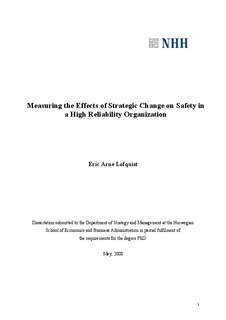| dc.description.abstract | This study explores how strategic organizational change affects safety as an outcome variable
in a high reliability organization (HRO). High reliability organizations are defined as
organizations operating in high-risk industries that achieve exceptionally high levels of safety
performance. Based on the assumption that HROs achieve these high levels of safety
performance through stable safety processes produced by common organizational structures
such as: learning environments, highly regulated activities, redundancy, local ownership of
tasks, and strong supporting safety cultures, I will study how potentially destabilizing
deliberate change processes affect safety as an outcome, over time, in a live single
longitudinal case study. This study sets out to answer two questions:
(1) How does the interaction between leadership choices and actions, and
organizational culture type affect attitudes towards change in a high reliability
organization?
(2) How do the relationships between leadership choices and actions during
strategic change, safety climate in place, and employee attitudes toward change,
affect safety as an outcome variable?
A deliberate strategic change initiative known as corporatization is studied over a three
year period in the Norwegian air navigation services provider - Avinor - with particular
focus upon four embedded units that experience three different phases of a common
deliberate change process. The findings indicate that the individuals at each embedded
unit experience the change process differently regarding both the local leadership and
the safety climate in place with varying effects on attitudes and perceptions. However,
the findings also show that the attitudes and perceptions toward the top leadership, and
the top leadership’s commitment to safety, in particular, are consistently reduced during
the time period studied and do not vary across the embedded units.
This study focuses on how a mismatch between organizational culture type and
strategic change type affects change implementation success. Furthermore, the study
shows how this mismatch affects individual attitudes and perceptions toward change,
and how these, in turn, affect perceptions of safety for front-line employees directly
responsible for safety outcomes. It is argued that different organizational culture types
demand specific change types to ensure success. It is also argued that a mismatch
between culture and change types can lead to a loss of trust in the leadership and
resistance to change that can, in the worst case, lead to the collapse of the change
process.
Propositions on how changes in perceptions and attitudes affect safety are presented in
a structural equation model, and show that individual perceptions of the leadership’s
commitment to safety and safety climate have strong positive causal relationships to
both attitudes toward change and perceptions of safety. The findings indicate that
individual perceptions of the leadership’s commitment to safety have important
implications to both change success and safety as an outcome. | en |
